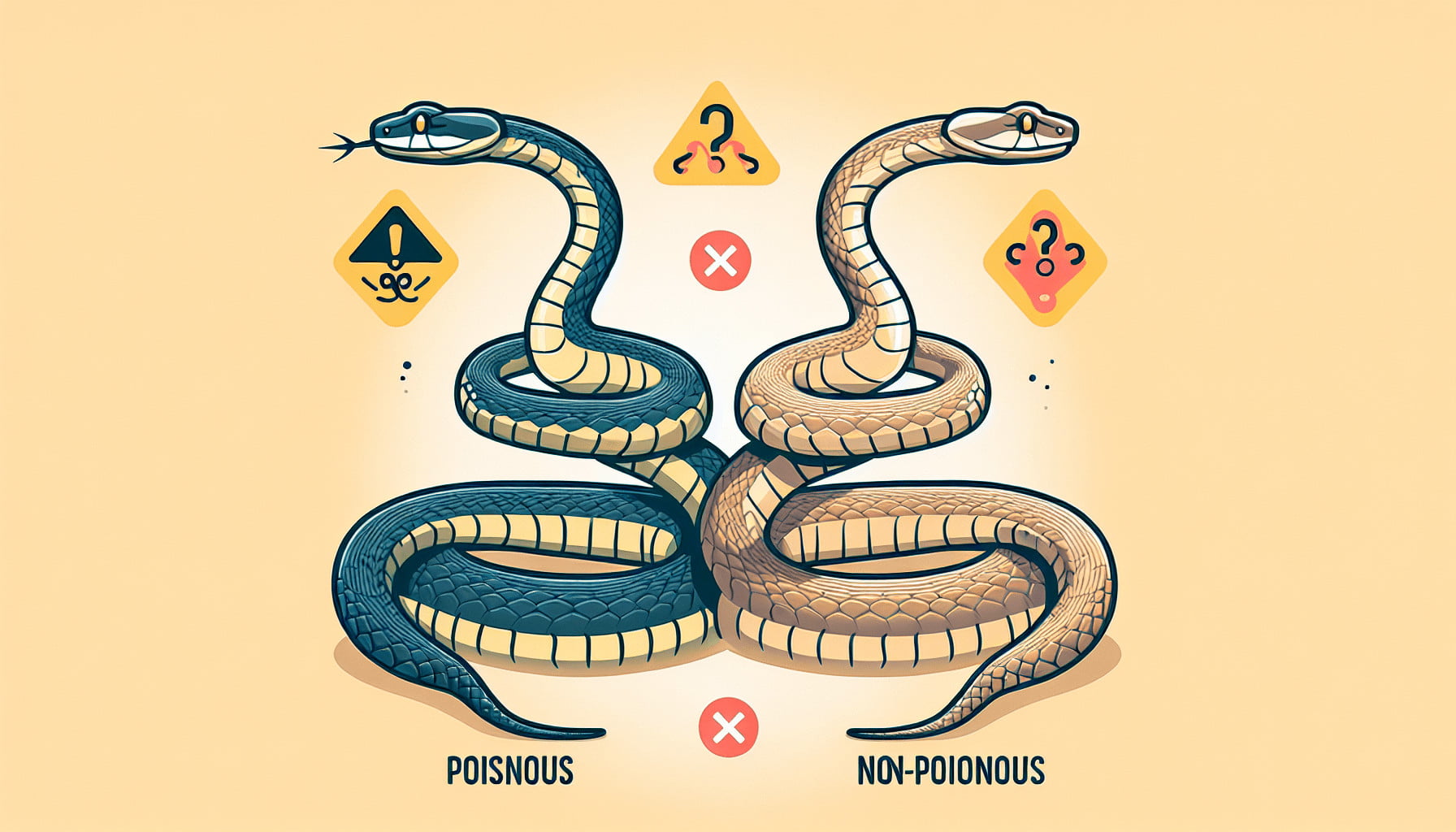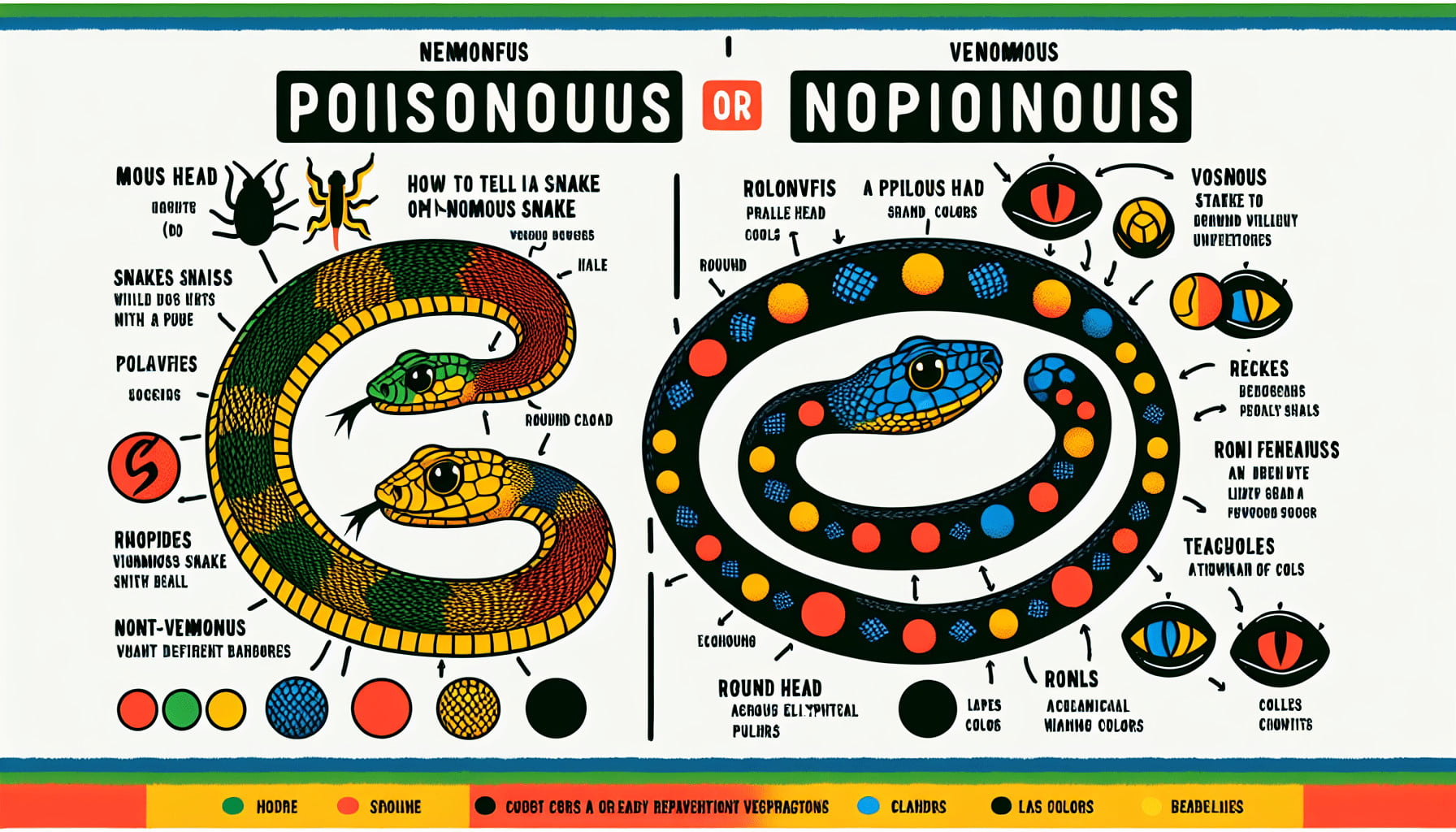So, you’re out exploring the great outdoors and you come across a snake. The question on your mind is, “Is this snake poisonous?” Well, fear not my friend, because in this article, we’ll cover some simple tips on how to determine if a snake is poisonous or non-poisonous. From examining the snake’s physical characteristics to observing its behavior, we’ll equip you with the knowledge you need to confidently identify whether you’re dealing with a venomous serpent or just a harmless slithering friend.
Physical Characteristics
Snakes come in a variety of shapes, sizes, and colors. Understanding their physical characteristics can help you determine whether a snake is venomous or non-venomous. Here are some key features to look out for:
Head Shape
The shape of a snake’s head can provide important clues about its venomous or non-venomous nature. Most venomous snakes, such as rattlesnakes and cobras, have triangular-shaped heads. The width of the head is noticeably wider than their necks, giving them a distinct arrowhead-like appearance. On the other hand, non-venomous snakes typically have rounded or narrow heads, with a more gradual transition between their head and neck.
Pupil Shape
Another characteristic to consider is the shape of a snake’s pupils. Venomous snakes often have vertical or slit-like pupils, similar to a cat’s eyes. These pupils allow them to control and adjust the amount of light entering their eyes, aiding in their ability to hunt and track prey. Non-venomous snakes, on the other hand, have round pupils, which are more commonly seen in humans.
Scales
Scales play a vital role in snake identification. Venomous snakes typically have rough scales, which help them retain moisture and provide traction while moving over different surfaces. In contrast, non-venomous snakes usually have smooth scales, providing a sleek and glossy appearance.
Coloration
Coloration can be highly variable among both venomous and non-venomous snakes, making it a less reliable indicator on its own. However, some venomous snakes, such as coral snakes, display bright and contrasting color patterns with vibrant red, yellow, and black bands. These distinctive colors act as a warning to potential predators to stay away. Non-venomous snakes often have more muted or earth-toned colors, blending in with their environment to avoid detection.
Behavioral Traits
Understanding the behavioral traits of snakes can also help you differentiate between venomous and non-venomous species. Here are some key indicators:
Aggression
Venomous snakes, especially when threatened, tend to exhibit more aggressive behavior compared to non-venomous snakes. They may coil their bodies, hiss, strike defensively, or even stand their ground. Non-venomous snakes, on the other hand, are generally more inclined to retreat and avoid confrontation.
Warning Signs
Venomous snakes often display warning signs before attacking. These signs can include vibrating their tail rapidly, known as “rattling” in some species, producing a distinct rattling sound. However, not all venomous snakes have rattles, so it’s important to look for other indicators as well.
Rattles
Rattlesnakes are infamous for the rattles located at the tips of their tails. When threatened, they shake these rattles, creating a distinctive sound that serves as a warning for potential predators or intruders to stay away. If you encounter a snake with a rattle, it is crucial to exercise extreme caution and give it a wide berth.

Habitat and Geographic Location
Knowing the distribution and prevalence of venomous and non-venomous snakes in your area is essential for your safety. Here are some important points to consider:
Distribution
Venomous snakes are found in various parts of the world, but their distribution can vary significantly depending on the species. For example, rattlesnakes are prevalent in North and South America, while cobras are typically found in Africa and Asia. Non-venomous snakes, on the other hand, have a more widespread distribution and can be found in almost every habitat around the globe.
Known Venomous Species
It’s important to familiarize yourself with the venomous snake species that exist in your region. In North America, for instance, venomous snakes include copperheads, cottonmouths, and rattlesnakes. In other regions, species like vipers, cobras, and coral snakes may pose a threat. Researching and identifying the specific venomous snakes in your area can help you stay vigilant and take appropriate precautions.
Known Non-Venomous Species
Non-venomous snakes are generally harmless to humans and play beneficial roles in ecosystems by controlling rodent populations. In many areas, non-venomous species such as garter snakes, rat snakes, and king snakes are common. Recognizing these non-venomous species can help alleviate unnecessary fear when encountering snakes in the wild.
Venomous Snake Identification
If you come across a snake and suspect it may be venomous, careful observation of certain distinguishing characteristics can help confirm your suspicions. Here are some key identification factors for venomous snakes:
Triangle-Shaped Head
Venomous snakes typically have triangular-shaped heads, distinct from their relatively thin necks. The wider head, resembling an arrowhead, contains venom glands and provides space for their hollow, hinged fangs. This triangular head shape is a clear warning sign that the snake should be treated with caution.
Vertical Pupils
One of the most reliable ways to identify a venomous snake is by its eyes. Many venomous species possess vertical or slit-like pupils that can retract, similar to a cat’s eye. This adaptation enables them to control the amount of light entering their eyes, allowing for better precision and depth perception during hunting.
Presence of Fangs
Fangs are specialized teeth found in venomous snakes that inject venom into their prey or potential threats. When venomous snakes open their mouths, their hinged, hollow fangs extend and become visible. These fangs are located towards the front of the snake’s mouth and are usually longer and more prominent than the teeth found in non-venomous snakes.
Heat Sensing Pits
Many venomous snakes, particularly pit vipers such as rattlesnakes and copperheads, possess specialized heat-sensing pits located on either side of their heads, between the nostrils and eyes. These sensitive pits allow them to detect and precisely locate warm-blooded prey, like rodents, even in darkness or obscured environments. The absence of these heat-sensing pits is a strong indicator that a snake is non-venomous.

Non-Venomous Snake Identification
Recognizing non-venomous snakes is equally important as identifying venomous ones to avoid unnecessary fear or panic. Here are some key features to look for when determining if a snake is non-venomous:
Round or Narrow Head
Non-venomous snakes typically have rounded or narrow heads, lacking the distinct triangular shape found in venomous snakes. Their head shape smoothly transitions into their neck, without any pronounced width difference.
Round Pupils
Unlike their venomous counterparts, non-venomous snakes often have round pupils, similar to the pupils found in humans. These round pupils do not possess the vertical or slit-like appearance seen in venomous species.
Lack of Fangs
Non-venomous snakes lack elongated fangs in their mouths. Instead, they have rows of small, uniform teeth. These teeth enable them to capture and devour their prey but do not possess the specialized adaptation for venom delivery.
Absence of Heat Sensing Pits
Non-venomous snakes do not possess heat-sensing pits on their heads. This absence of specialized sensory organs distinguishes them from venomous snakes, such as pit vipers, which rely on infrared detection to locate warm-blooded prey.
Researching Snake Species
Educating yourself about local snake species is crucial for recognizing venomous and non-venomous snakes. Here are some valuable resources to help you gather relevant information:
Field Guides and Online Resources
Field guides specifically tailored to your geographic region are excellent resources for identifying snakes. These guides often provide detailed descriptions, photographs, and distribution maps of different species. Online resources, such as reputable herpetological society websites, also offer comprehensive information on snake species.
Consulting Local Experts
Seeking advice or guidance from local snake experts, such as herpetologists or experienced individuals working in conservation organizations, can provide valuable insights. Local experts can offer region-specific knowledge, answer your questions, and guide you in identifying venomous and non-venomous snakes in your area.
Seeking Professional Assistance
If you encounter a snake and feel unsure about its venomous or non-venomous nature, it’s best to seek professional assistance. Here are some options to consider:
Contacting Local Snake Experts
Reach out to local experts, such as snake enthusiasts, herpetologists, or snake rescue organizations, who can provide guidance over the phone or may even be able to visit the location to assess the situation. These experts have experience in identifying and handling snakes, ensuring you receive accurate advice.
Calling Animal Control or Snake Removal Services
If you are unable to reach a local snake expert, contacting animal control or snake removal services can be a viable option. These professionals are trained in managing wildlife encounters and can safely remove the snake if needed.
Observing Snake Behavior
When encountering a snake, it’s important to observe their behavior from a safe distance. Here are some guidelines to follow:
Keeping a Safe Distance
Maintain a safe distance between yourself and the snake. A distance of at least 5-6 feet is recommended to minimize the risk of accidental snake bites. Remember, snakes typically prefer to flee rather than engage in confrontation.
Observing from a Distance
Watch the snake from a safe location, keeping in mind that snakes may behave differently when feeling threatened or cornered. Observe their movements, body language, and any warning signs they may exhibit.
Avoiding Provoking the Snake
Do not provoke or attempt to handle the snake unless you are a trained professional. Snakes interpret any disturbance as a possible threat and may become defensive or aggressive in response. It’s crucial to give them space and avoid any actions that may escalate the situation.
Safety Precautions
When spending time in snake-prone areas, taking safety precautions can significantly reduce the risk of snake bites. Here are some precautions to consider:
Wearing Protective Clothing
When venturing into snake habitats, wear clothing that provides a layer of protection. Long pants, boots, and thick socks can help prevent snake bites if a snake were to strike at your lower legs or feet. Avoid wearing sandals or going barefoot in snake-prone areas.
Using Snake Hooks or Tongs
If you need to move a snake or keep it at a safe distance, using snake hooks or tongs is recommended. These tools allow you to handle the snake from a safe distance, reducing the risk of accidental bites. Remember to exercise caution even when using these tools and avoid any sudden or aggressive movements that may startle the snake.
Dealing with Snake Bites
In the unfortunate event of a snake bite, taking prompt action can make a significant difference in minimizing the impact of venom. Here are some essential steps to follow:
Applying First Aid
If bitten by a snake, it’s important to stay calm. Immobilize the bitten limb and keep it below heart level, if possible. Remove any constricting clothing or jewelry near the bite site to prevent swelling. Clean the wound gently with mild soap and water, but avoid applying a tourniquet or sucking out the venom as these methods can be harmful.
Seeking Medical Attention
Regardless of whether you think the snake was venomous or non-venomous, seeking immediate medical attention is crucial. Emergency medical professionals are equipped to assess the situation, administer appropriate treatments, and monitor for any adverse reactions. Remember, snakebites can have serious consequences, and professional medical care is essential for the best outcome.
By understanding the physical characteristics, behavioral traits, and habitat of different snake species, you can make more informed decisions and take appropriate precautions when encountering snakes. Remember, the best strategy when it comes to snakes is to respect their space, observe them from a distance, and seek professional assistance when needed.
